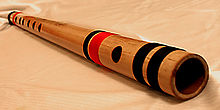Bansuri

Bansuri ( Hindi बांसुरी , IAST baṃsurī ), also bansi, bansri, basuri, bas, basi, basli, basuli stands in several North Indian languages for many different types of flutes , mostly for transverse flutes that are played in Indian music . The bansuri are often made of bamboo, and other materials have been handed down for the name of the flute , which goes back to the 1st millennium. The root of the word is Sanskrit vamsha ("bamboo", "flute").
Design and style of play
The bansuri is made in different lengths, usually around 50 centimeters, and has six or seven finger holes. The near end is closed, the far end is open. It has no mouthpiece and is tuned diatonic . Halftones can be created by partially covering the finger holes or changing the angle of attack, as can the ornaments that are important in Indian music such as glissandi and shruti .
The bansuri is played in the folk and classical music of northern India. The best known musician on this instrument is Hariprasad Chaurasia , who made recordings in the West with John McLaughlin and Jan Garbarek, among others . One of the most famous flute players in India is Ronu Majumdar, who also performed with Ravi Shankar and George Harrison . In addition, Raghunath Seth became known in Europe through his recordings (with jazz flutist Chris Hinze ) and Rupak Kulkarni (with Stefan Rigert's Talking Drums ). Pandit Pannalal Ghosh (1911–1960) was a famous flutist from Bengal who made the bansuri a concert instrument. Like Gosh, Nityanand Haldipur (* 1948 in Mumbai ) represents the strict style of Maihar Gharana .
Origin and Distribution
Flutes appear more than once on stone reliefs on the stupa of Sanchi in 1st century. Chr. On. Cave paintings in Ajanta around 700 also show flutes. A sign of her advanced age is that she is the attribute of the god Krishna , who plays her in the circle of shepherd girls ( gopis ) and is portrayed with the flute in the Ras lila dance theater . His flute is called murali . It symbolically stands for the instrument that God plays on to cast a spell over people.
The names of bamboo flutes in India include bansi, bansari, bansuli, bansri and vamshi as well as murali, pava and kolalu . The name found its way from India to Southeast Asia, where in Java the old bamboo flute bansuli ( vansali ) became today's flute suling . In Sumatra , bansi is a type of saluang . The South Indian bamboo flute venu is much smaller than the flute played in classical North Indian music.
The distance from the near end to the blowhole is three to eight centimeters on the Indian flutes. Exceptions are the rare flutes blown in the middle, such as the surpava in Maharashtra and the veno in Gujarat .
Web links
- David Courtney: Bansuri and Venu. chandrakantha.com
Individual evidence
- ↑ Sina Vodjani and Gabriele von Kröcher: Zarathustra. Membrane International, Hamburg 2006, ISBN 978-3-86562-739-1 , p. 102 f.
- ↑ Sina Vodjani and Gabriele von Kröcher: Zarathustra. Membrane International, Hamburg 2006, ISBN 978-3-86562-739-1 , p. 104
